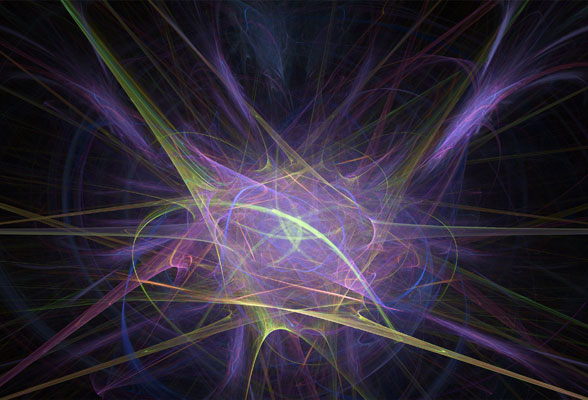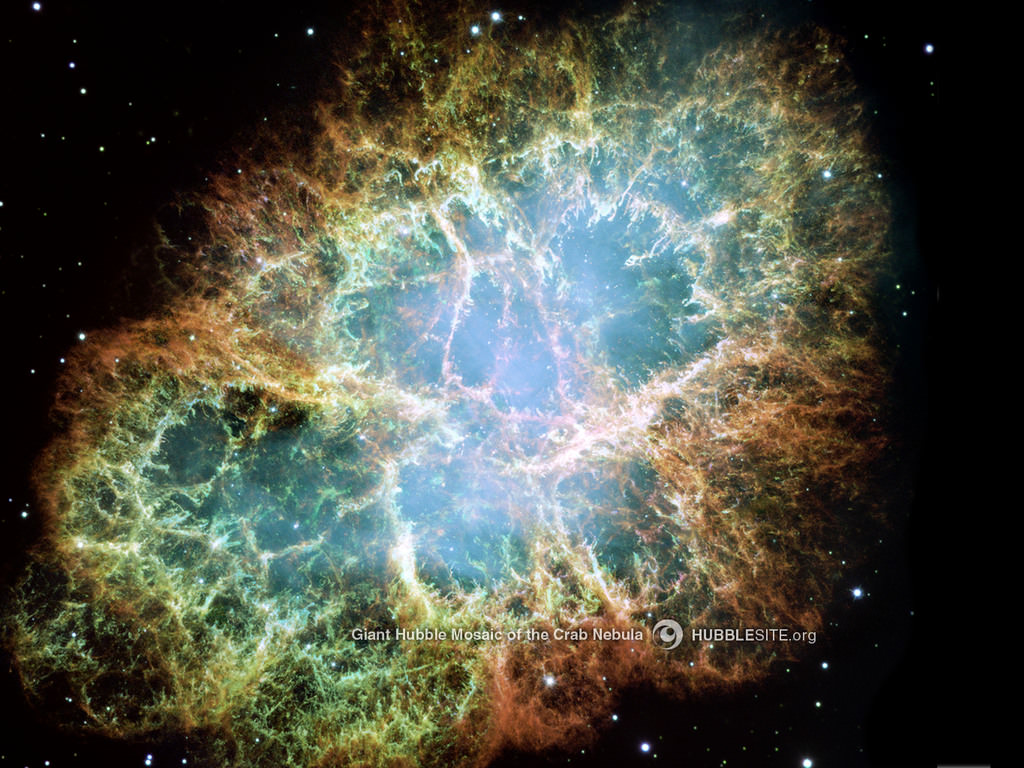In this post, I'm going to briefly explain basically how everything started, and eventually evolved.
The Beginning: the Big BANG!
No one's sure how the universe really began, but the most convincing and widely accepted theory is that the universe started as literally nothing, and then exploded in what we call: The Big Bang. The vast explosion generated space and time and created all the matter and energy in the universe. Exactly how was this triggered? Well, this is still much of a mystery, but astronomers believe it was caused by "inflation", where a peculiar energy in a vacuum of space was suddenly mobilized. The expansion was only ended when the inflation energy was transformed into more familiar forms of matter and energy.
 |
| String Theory Big Bang No Copyright intended, taken from Krishna.org |
The Fundamentals Form 1 second after the Big Bang
About a second after the initial Big Bang, the tiny fraction of time that the inflation took place in, the universe started to cool, and slow down. It was still expanding, but not nearly as fast. As it did this, the four most basic types of forces in nature were formed: gravity - the force where physical bodies attract to each other proportional to their mass (however not evident in really small things in the quantum world), the strong force - which hold the nuclei of atoms together (which without it, there pretty much wouldn't be any atoms), the weak force - which is responsible for radioactivity among other things, and electromagnetism - which involves the interaction of electricity and magnetism. Other fundamental particles such as quarks - quarks and leptons are the most basic building blocks or matter, electrons - which are stable subatomic particles with negative charges, and create electricity, photons - a particle that represents a quantum or light or other electromagnetic radiation, and neutrinos - a neutral (no charge) subatomic particle with a mass close to zero, began to form. With this, proton and neutrons - which make up an atom's nucleus, began to form as well.
 |
| the 4 basic forces of nature No copyright intended, taken from PBS.org |
Hydrogen and Helium 3 minutes after the Big Bang
Within a few minutes, the universe as we know it, begun to take shape. Already incomprehensibly large, the protons and neutrons started coming together to form the nuclei of two of the most basic elements - hydrogen and helium. Much of the universe is now made up of these two fundamental, but extremely important elements.
 |
| Hydrogen, the most basic element in the universe No Copyright intended, taken from dieselpowermag.com |
The Cooling Begins 500,000 years after the Big Bang
For the next few hundred thousand years afterward, the universe remained a large expanding gas consisting of the hydrogen and helium nuclei. And as the gas cooled, electrons started combining with the hydrogen and helium nuclei. Photons were rushed outwards, instead of being scattered. Believe it or not, we can still see the photons emitted from this early time period!
A Star is Born 1,000,000,000 years after the Big Bang
As time passed, gravity started impacting the universe more and more. Happy 1 billionth birthday, Universe! The universe is still expanding, but now pockets of primordial gas became more and more dense. With this, stars began to ignite from these pockets. Groups of these stars formed the earliest galaxies.
 |
| Stars being born in a nebula No Copyright intended, taken from http://scienceblogs.com/ |
The Era of Quasars 3,000,000,000 years after the Big Bang
For the next 2 billion years, small galaxies started combining to form larger ones. These larger galaxies, known as elliptical galaxies, started forming an array of shapes resembling spirals and spheres. Sometimes the merges were so violent that the stars and gas collapsed into a center, known as a black hole. Imagine taking something far larger than the Sun, and squeezing it to the size of a marble. The gravity would be so strong that not even light could escape it. These is what black holes are. The gas flowing into these black holes became so hot that they glowed brightly before disappearing. The light of these so called "quasars" could be seen across the universe.
 |
| a Quasar, No Copyright intended, taken from wikipedia.org |
Supernova 9933 6,000,000,000 years after the Big Bang
Across the universe, some stars were being born, while others started to die. Often, stars die in huge cataclysmic explosions, called supernovae. However, these huge explosions were vital to the evolution of galaxies - distributing many common elements, such as oxygen, iron, calcium, carbon, nitrogen, and for heavier stars: gold, silver, lead, and uranium, into interstellar space.
 |
| Crab Nebula - formed by a Supernova, where stars are born No Copyright intended, taken from hubblesite.org |
Our Sun is Born, A Solar System Forms ~9,000,000,000 years after the Big Bang
About 4.5 million years ago, our Sun is born in what we call the Milky Way galaxy. After a while, gas around the Sun started collapsing into planets and dwarf planets, creating the solar system we know today - Mercury, Venus, Earth, Mars, the Asteroid Belt and dwarf planet Ceres, Jupiter, Saturn, Uranus, Neptune, the Kuiper Belt with comets and dwarf planets Pluto and Eris among others, and finally final outer layers such as the Oort Cloud.
There is also a relatively new discovery, on dark energy and dark matter. Much more is unknown about these substances than is known. What we do know is that dark energy has a lot to do with the acceleration of the expanding universe and that it makes up 70% of our universe. Dark matter makes up around 25% of Universe. This leaves less than 5% of the universe for everything else. Imagine it! Living in a world where we have no idea what 95% of it is! It's like not knowing what the heck water and magma is!
 |
| Our Solar System, No Copyright intended, taken from crystalinks.com |
 |
| Dark Matter, No Copyright intended, taken from newscientist.com |
But What About Our Future?
Scientists are predicting that the Milky Way and our nearest galactic neighbor Andromeda will collide.
The universe is ever expanding, and we are discovering that "vacuum energy" is overtaking the force of gravity into expanding quicker and quicker. Soon we will be too far away from other galaxies to see anything. We would look into the sky and see nothing but empty space. And sooner or later, this vacuum energy will even start ripping galaxies apart.
But before any of this happens, the Sun will already have burned out (it is currently in the middle of it's life stage, scientists estimate it's lifetime to be 9 billion years), and Earth will have already died.
100 billion years after the Big Bang, the Stellar Era will eventually end, and our Universe will begin to die.
10 trillion trillion trillion years after the Big Bang, most of the universe may have already blown up and collapsed into black holes and neutron stars in the Degenerate Era.
10,000 trillion trillion trillion trillion trillion trillion trillion trillion years after the Big Bang, we will go into the Black Hole Era. And finally after all the black holes decay, the universe will pretty much come to an end as we know it in the Dark Era. But who knows? Maybe another Big Bang will happen once that time comes, and spark another birth of the Universe.
 | ||
| Galaxies Colliding, No Copyright intended, taken from http://galaxiescollide.webs.com/ |
 |
| A Black Hole, No Copyright intended, by Alain Riazuelo |
 |
| The Big Bang Theory Graphic, No Copyright intended, by Ed Gabel A Brief History of the Universe, by theHistoryChanel, uploaded by SonOfCyrusTheGreat |
The Big Bang According to Steven Hawking
What Caused the Big Bang? by Tony Darnell
Please note: I am NOT an expert. I am only a middle-schooler with a curious passion for knowledge.
no copyright intended
Sources and Other Cool Websites:
NOVA History of the Universe Interactive (I strongly recommend this, really cool!)
I give most of my credit to this, as I based my entire post on it
http://www.pbs.org/wgbh/nova/space/history-universe.html
NASA Dark Matter Dark Energy
http://science.nasa.gov/astrophysics/focus-areas/what-is-dark-energy/
HubbleSite Black Holes
http://hubblesite.org/explore_astronomy/black_holes/home.html
NationalGeographic Solar Systems
http://science.nationalgeographic.com/science/space/solar-system/
Space.com When Galaxies Collide
http://www.space.com/12642-milky-andromeda-galaxy-collision-interview.html
NASA Imagine the Universe Supernovae
http://imagine.gsfc.nasa.gov/docs/science/know_l2/supernovae.html
and many more...
No comments:
Post a Comment
I hope you have something worthwhile to say. >:(
lol jk say watever :D